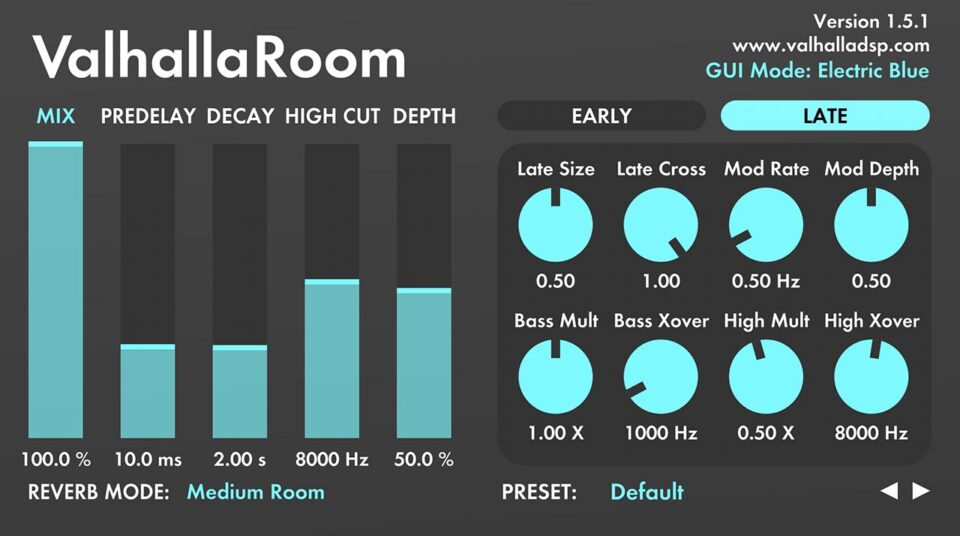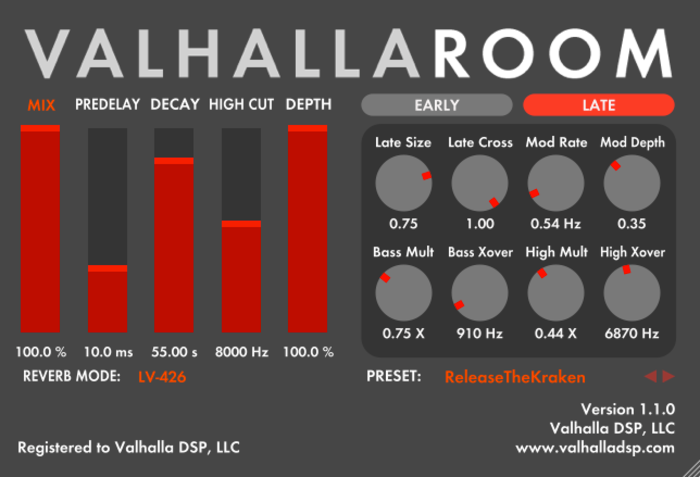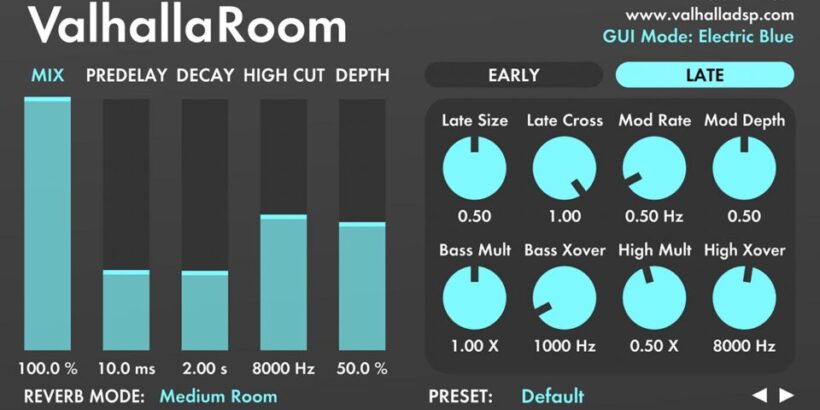Valhalla Room Crack + Product Key

Valhalla Room Crack is a true general-purpose algorithmic stereo reverb. It features twelve original reverb algorithms (including the latest Dark, Nostromo, Narcissus, Sulaco, and LV-426 reverb modes) and produces a wide range of natural reverb sounds. The sounds range from tight environments and spaces to traditional room and panel sounds to widely modulated spaces. The algorithm designs were influenced by some of the “classic” room simulation boxes as well as by the most modern theory. ValhallaRoom was designed from a psychoacoustic perspective. Rather than creating a simplified physical model of a simplified physical space, Room creates early and late acoustic energy that provides the spatial and phase cues needed to create an “idealized” sense of space. Designed to mimic large rooms with a spacious feel, with “detuning” modulation. The decay is a bit sparse at first but quickly reaches a high reflection density. The Large Room algorithm has a very exponential decay with precise control over the frequency balance of the decay over time.
There is a slight high-frequency absorption inherent in the Large Room algorithm, reflecting the effects of air on the high frequencies. The modulation in the Large Room algorithm is designed to create a wide stereo image but without causing random pitch shifts in the decay. Now that ValhallaRoom for OSX and Windows is out I want to publish some blog posts about reverb, how to dial in the sound you want, tips and tricks, etc. First, let’s take a look at the GUI and go through the different sections of ValhallaRoom At the top is the title of the plugin, “VALHALLAROOM”. This is where my love of typography comes into its own. Futura Demibold is displayed as prominently as possible. From a design point of view, the title is used to compensate for the large blank space at the bottom of the plugin (the purpose of this blank space is explained below). At the bottom left of the title are five vertical sliders. These sliders (Mix, Predelay, Decay, High Cut, Depth) are the controls that have the most immediate dramatic effect on the sound and are probably the most commonly used.
You may also like this Reveal Vst Crack
Valhalla Room Crack Features
- The buttons below and to the right of the title select whether to edit the Early Reverb or Late Reverb section.
- Red means the specified section is edited, gray means it isn’t. Below the Early/Late knobs are the Early/Late reverb parameter control knobs.
- These settings tend to be “more accurate” than larger slides in red, allowing the user to choose from different views as needed Valhalla Room Product Key.
- In the area below the sliders is the Reverb Mode selector. This lets you choose one of four reverb algorithms, each with a distinctive sound.
- In the area below the Early/Late buttons is the Preset area. The currently active preset is shown as a red title on a charcoal gray background.
- Click the red word to bring up the presets menu, where you can browse, load and save presets,
- copy the current state of the plug-in to the clipboard, and clipboard data to the plug-in (a great way to import presets via exchange e-mail or forum).
- The black area at the bottom of the plugin window is where tooltips appear.
- Hover your cursor over a slider, knob, button, etc., and a tooltip will appear in that section with a brief explanation of how to use that control.
Valhalla Room Crack System Requirements
- Reverb mode is another reverb algorithm. It has a different configuration of delay lines, filters, matrices, etc. compared to other modes and has its own inherent characteristics.
- The preset is “a collection of parameters for a specific reverb mode that we gave a name to”.
- You can create small rooms with the Large Room mode and large reverbs with different algorithms.
- So not really “crazy” about how Valhalla plugins work. The mode always switches between different algorithms.
- Presets can use any of the modes because the mode is one of the selectable settings (and one of the most powerful settings) of Valhalla Room Serial Key.
- You can name the presets anything you want. The large room algorithm with a small early/late size and short reverb time sounds like a small room.
- It’s a flexible tool. ValhallaShimmer was designed to achieve a variety of fat reverb tones with the ability to add graduated feedback to the decay.
- The “Shimmer” in the title refers to the classic shimmer effect used by U2, Brian Eno, Daniel Lanois, Coldplay, etc.

What’s new Valhalla Room Crack
- Adjust the Feedback knob for the amount of pitch change you want in the output signal, then use the Size knob to set the decay.
- Diffusion works best at around 0.9 for reverberant sounds. If you set Diffusion < 0.5, the sound will be more like an offset echo, which is another cool sound.
- Different pitch change modes have different “smoothness”: single and double pitch change modes have more noise in their decay Valhalla Room License Key.
- This is best for emulating orchestral sounds like those heard on “Deep Blue Day”.
- The SingleReverse and DualReverse pitch change modes are much smoother and better suited to organ sounds.
- Use the MediumStereo or BigStereo reverb modes for the smoothest shimmering sounds.
- The Mono Reverb mode has a stronger pitch change feel in the return signal, while the other modes have a smoother onset of pitch change.
- There are a few presets that come with ValhallaShimmer that replicate this effect, but if you want to compose your own version, here are some tips:
How to install it?
- The company name and URL are also shown in case you forget.
- The idea behind the GUI was to organize the controls logically so that their size and display state were an accurate representation of their relative importance.
- The GUI is also proudly 2D, with the controls being an abstraction of buttons and sliders rather than a surrogate representation of hardware that doesn’t exist.
- Futura Demibold was chosen as the font because it is specified as the panel font in NASA’s Acceptable Use Policy and because it looks cool.
- The tooltips section is an attempt to include documentation as a design element, in keeping with minimalist/Swiss School influences.
- The lower right corner shows the current version number along with relevant suffixes (b for beta, d for demo, PPC for Mac PowerPC).
Conclusion
the color mode should be set to dark. This creates a natural high-frequency roll-off that eliminates nearly all aliasing noise in the pitch shifter feedback path. Set the mod depth knob to a fairly low value at first, as changing the pitch introduces its own random modulation into the signal. Pitch shifting with feedback in reverb is an easy way to simulate the shimmering sound, but it won’t. the same. The best way to do this is to use an open-loop pitch shifter in a reverb, run one of the outputs through a mixer, and then feed the mixer channel’s output into one of the SE-70’s inputs. It can be choppy, but the original Eno/Lanois patch took that risk anyway. I used to run my SE-50 in pitch shift mode in a Boss RV-3 pedal and feed one of the RV-3’s outputs back into the SE-50. The best sound was achieved by placing a Moog Rogue in the feedback loop, using the filter and VCA to control the overall amount of feedback through the system Valhalla Room Vst,
Playing with the filter resonance was fun too. The system was very non-linear in contrast to ValhallaShimmer’s linear return. guess if you look at Brian Eno’s arsenal you might find your answers. From the wiki article on the same piece titled “Most of the instrumentation is Budd on an acoustic piano with treatments by Eno. ‘The Plateaux of Mirror’ and ‘Wind in Lonely Fences’ are played on an electric piano…” I’ll take a guess and tell you the shimmering synth sounds more than likely sound like a Yamaha CS-80 synth, or maybe even a Rhodes or Wurli EP 200 with a slight budd touch…or another bigger working electric piano synthesizer through very high-quality studio effects like and Eventide 2016 or maybe Lexicon 224…Back then digital reverb was VERY expensive to use on a daily basis. , even for someone like Brian Eno and blending the oscillator pitches as needed to get the initials of the pitches to reach…
